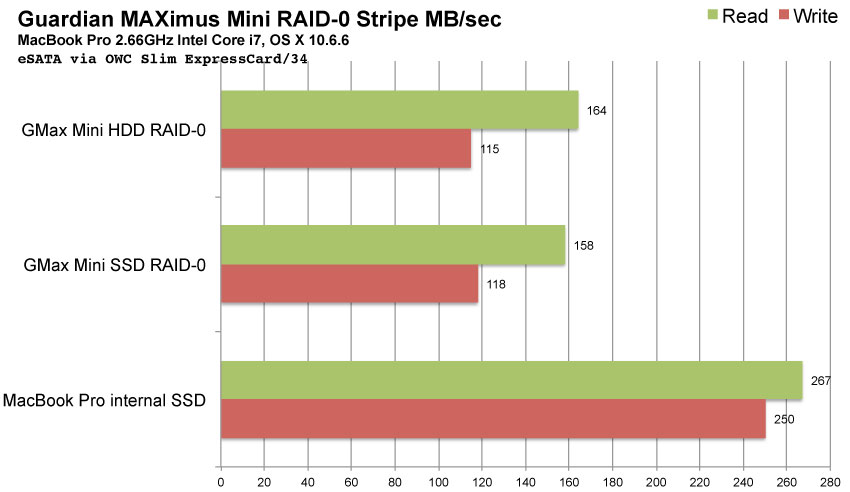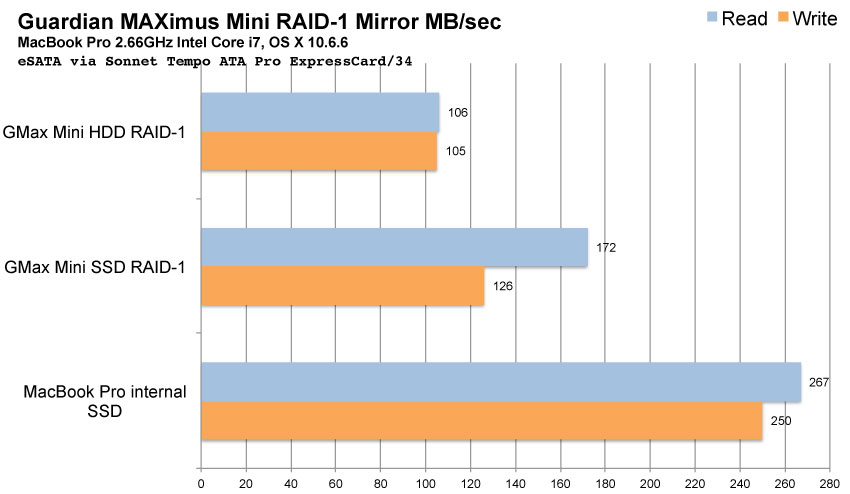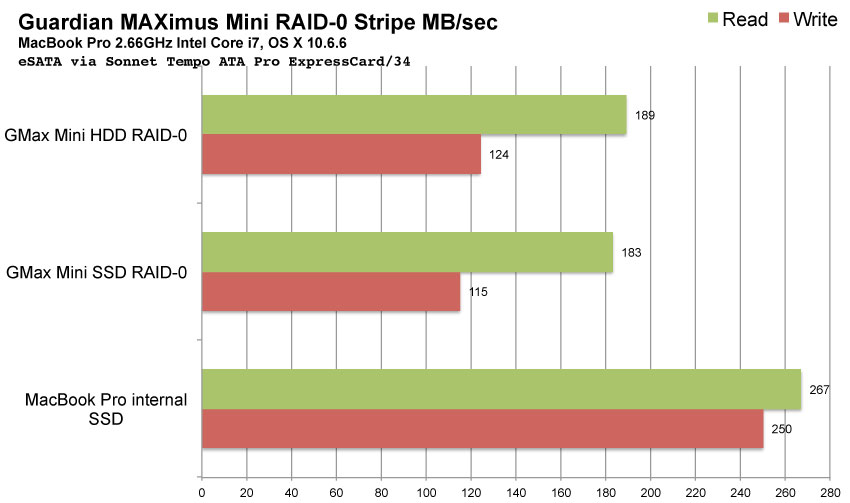
$220 SAVE $130 = 37.0% Western Digital 16.0TB Western Digital Ultrastar DC HC550 3.5-in… in Storage: Hard Drives
|

|

|

|

|

|

|

|

|

|
Performance on MacBook Pro with eSATA
Related: backup, eSATA, hard drive, laptop, Mac Pro, MacBook, MacBook Pro, Other World Computing, RAID, SSD, storage, USB
Performance on the MacBook Pro is hugely dependent on the interface: eSATA, Firewire 800 or USB.
This is mostly a limit of the connection on the MacBook Pro, not the drive.
To see the peak performance with fewer limits imposed by the interface, see the Mac Pro performance results.
eSATA
When connected with eSATA on the MacBook Pro, the ExpressCard/34 slot is throttled compared to internal SATA on the MacBook Pro, or eSATA on the Mac Pro. That’s just the way it is until the day when a better interface is available, and as of January 2011, only the 17" MacBook Pro even has the ExpressCard/34 slot that makes eSATA possible; the other models have only Firewire 800 and USB 2.
Firewire 800
See the Firewire test results for the MacBook Pro. When connected with Firewire 800, none of the drives can exceed about 84MB/sec reads at best (worse for writes), since that is the limit of Firewire 800 performance.
USB 2.0
Less than half the speed of Firewire 800. Forget USB 2.0.
Test Notes
Tested using the 2010 MacBook Pro Core i7 2.66GHz with two eSATA ExpressCard/34 cards, the Sonnet Tempo SATA Pro, and the OWC Slim eSATA ExpressCard/34.
HDD = Seagate Momentus 750GB hard disk Drive 7200 rpm
SSD = OWC Mercury Pro RE solid state drive
Neither eSATA card performed well compared to what eSATA can do on the Mac Pro or the internal SATA connector of the MacBook Pro, but that’s a limitation of the ExpressCard/34 slot on the MacBook Pro.
Performance: RAID-0 stripe sustained transfer rate
See test notes above.
Guardian Maximus Mini RAID-0
The SSD performance is worse than the hard drive performance, when it should be as fast as the interface allows. I have no explanation, and I repeated my tests with the same results multiple times.
The Sonnet Tempo SATA Pro card is marginally faster than the OWC Slim card. Given the large price difference, the choice is easy, though the Sonnet card does have two ports so that two devices can be connected at the same time.
Two graphs shown below, one for the Sonnet card, one for the OWC Slim card.
With Sonnet Tempo SATA Pro ExpressCard/34
Disappointing write performance well below the drive capabilities. Still, much faster than Firewire 800.
With OWC Slim ExpressCard/34
Disappointing write performance well below the drive capabilities. Still, much faster than Firewire 800.

disktester run-sequential
Performance: RAID-1 mirror sustained transfer rate
See test notes above.
For a RAID-1 mirror, performance of the SSD is notably better for reads than hard drives, and somewhat better for writes.
With Sonnet Tempo SATA Pro ExpressCard/34
Disappointing write performance well below the drive capabilities for the SSD, but matching the drive speed for hard drives. Much faster than Firewire 800.

disktester run-sequential
With OWC Slim ExpressCard/34
Disappointing write performance well below the drive capabilities for the SSD, but matching the drive speed for hard drives. Much faster than Firewire 800.

disktester run-sequential
Conclusions
RAID performance on the MacBook Pro via the ExpressCard/34 slot using eSATA cards is much better than Firewire 800 performance, but still greatly impaired compared to what the internal SATA port delivers with a single SSD.
The Apple MacBook Pro badly needs a new connectivity port, such as USB 3.0, or LightPeak, so that external drive performance can leap forward.
Seagate 22TB IronWolf Pro 7200 rpm SATA III 3.5" Internal NAS HDD (CMR)
SAVE $100

 diglloydTools™
diglloydTools™


